Analyzing Motivation Theories: Maslow, Herzberg, and Employee Needs
VerifiedAdded on 2020/10/22
|7
|1506
|135
Essay
AI Summary
This essay provides a comprehensive overview of motivation theories, with a particular focus on comparing and contrasting Maslow's Hierarchy of Needs and Herzberg's Two-Factor Theory. The essay begins by defining motivation and its importance in driving individual and organizational success. It then delves into the specifics of Maslow's theory, outlining the hierarchy of needs from physiological to self-actualization, and Herzberg's theory, which differentiates between hygiene and motivational factors. The essay analyzes how these theories can be applied to manage change in the business environment and meet the needs of both individuals and the organization. It discusses practical strategies for motivating employees, such as providing recognition, fostering a healthy work-life balance, and offering rewards. The conclusion emphasizes the crucial role of a motivated workforce in achieving organizational goals and highlights the significance of understanding and applying these motivational theories for effective leadership and enhanced productivity. The essay is supported by various references from books and journals.
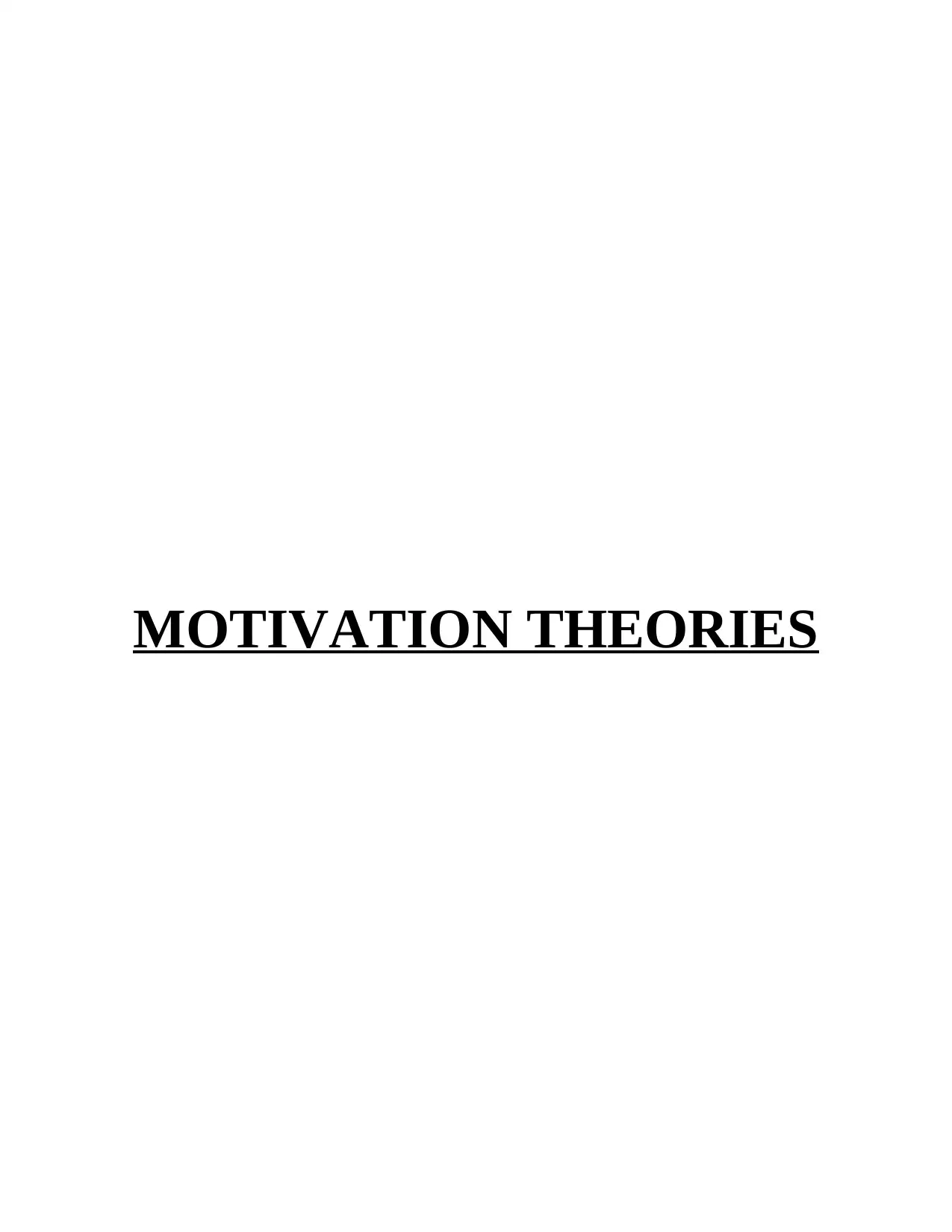
MOTIVATION THEORIES
Paraphrase This Document
Need a fresh take? Get an instant paraphrase of this document with our AI Paraphraser
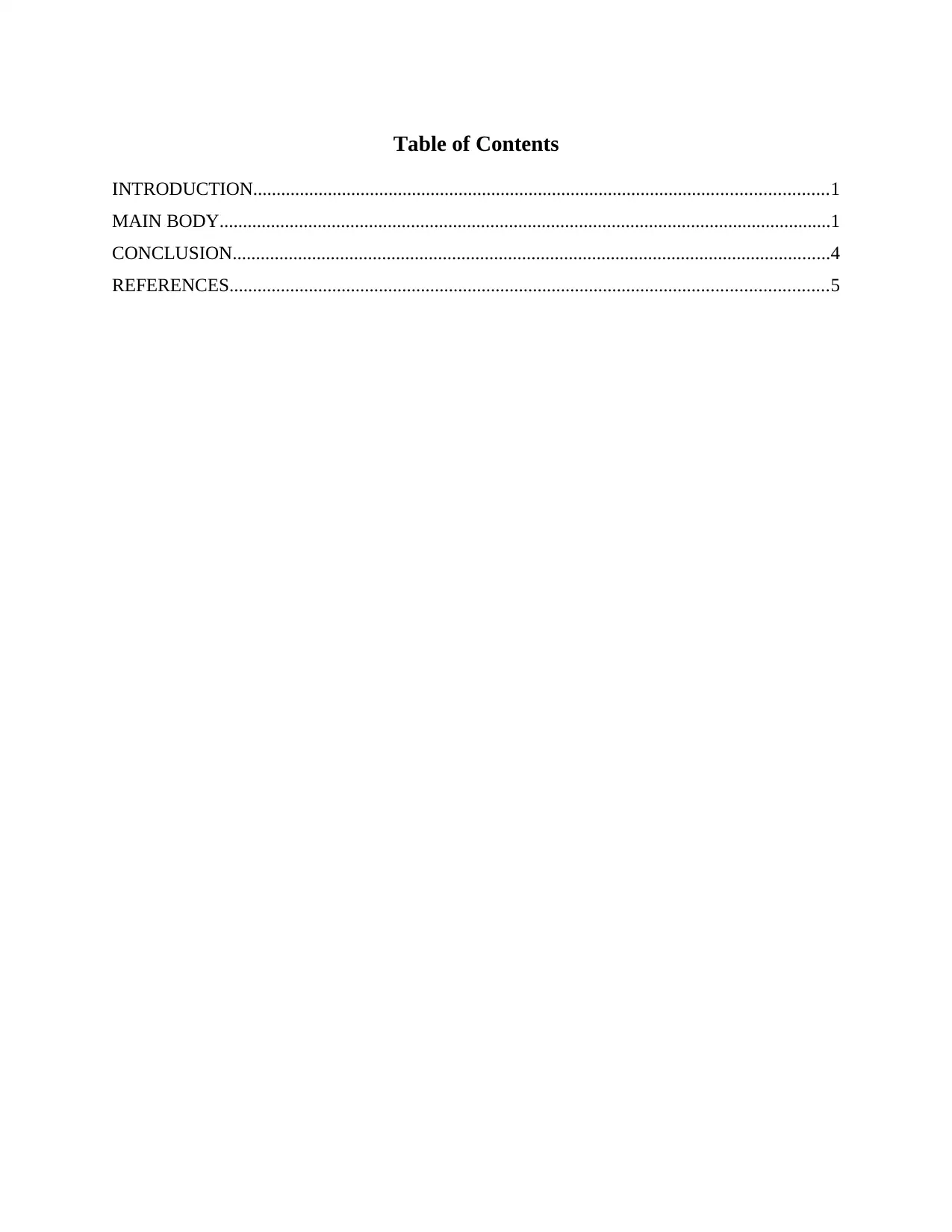
Table of Contents
INTRODUCTION...........................................................................................................................1
MAIN BODY...................................................................................................................................1
CONCLUSION................................................................................................................................4
REFERENCES................................................................................................................................5
INTRODUCTION...........................................................................................................................1
MAIN BODY...................................................................................................................................1
CONCLUSION................................................................................................................................4
REFERENCES................................................................................................................................5
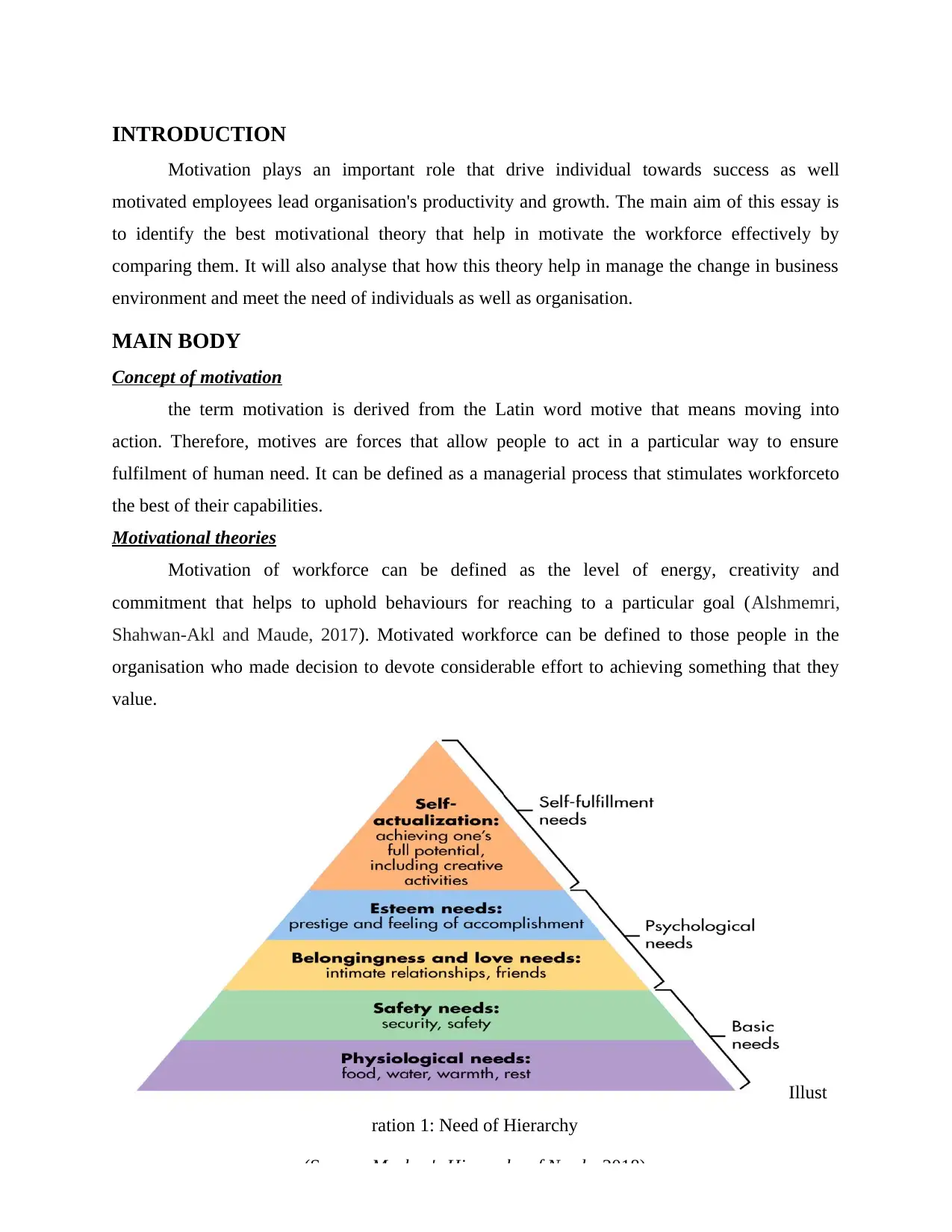
INTRODUCTION
Motivation plays an important role that drive individual towards success as well
motivated employees lead organisation's productivity and growth. The main aim of this essay is
to identify the best motivational theory that help in motivate the workforce effectively by
comparing them. It will also analyse that how this theory help in manage the change in business
environment and meet the need of individuals as well as organisation.
MAIN BODY
Concept of motivation
the term motivation is derived from the Latin word motive that means moving into
action. Therefore, motives are forces that allow people to act in a particular way to ensure
fulfilment of human need. It can be defined as a managerial process that stimulates workforceto
the best of their capabilities.
Motivational theories
Motivation of workforce can be defined as the level of energy, creativity and
commitment that helps to uphold behaviours for reaching to a particular goal (Alshmemri,
Shahwan-Akl and Maude, 2017). Motivated workforce can be defined to those people in the
organisation who made decision to devote considerable effort to achieving something that they
value.
1
Illust
ration 1: Need of Hierarchy
(Source: Maslow's Hierarchy of Needs, 2018)
Motivation plays an important role that drive individual towards success as well
motivated employees lead organisation's productivity and growth. The main aim of this essay is
to identify the best motivational theory that help in motivate the workforce effectively by
comparing them. It will also analyse that how this theory help in manage the change in business
environment and meet the need of individuals as well as organisation.
MAIN BODY
Concept of motivation
the term motivation is derived from the Latin word motive that means moving into
action. Therefore, motives are forces that allow people to act in a particular way to ensure
fulfilment of human need. It can be defined as a managerial process that stimulates workforceto
the best of their capabilities.
Motivational theories
Motivation of workforce can be defined as the level of energy, creativity and
commitment that helps to uphold behaviours for reaching to a particular goal (Alshmemri,
Shahwan-Akl and Maude, 2017). Motivated workforce can be defined to those people in the
organisation who made decision to devote considerable effort to achieving something that they
value.
1
Illust
ration 1: Need of Hierarchy
(Source: Maslow's Hierarchy of Needs, 2018)
⊘ This is a preview!⊘
Do you want full access?
Subscribe today to unlock all pages.

Trusted by 1+ million students worldwide
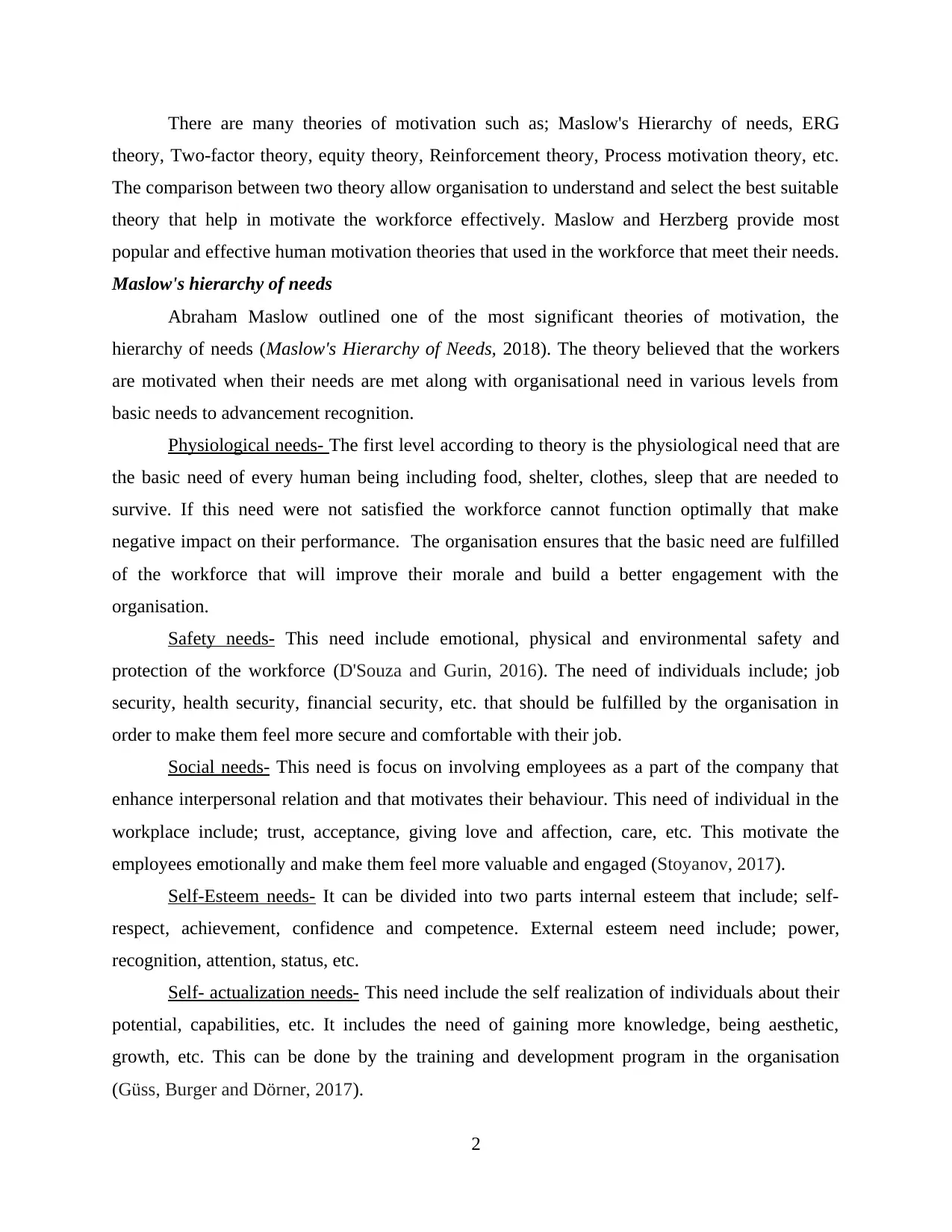
There are many theories of motivation such as; Maslow's Hierarchy of needs, ERG
theory, Two-factor theory, equity theory, Reinforcement theory, Process motivation theory, etc.
The comparison between two theory allow organisation to understand and select the best suitable
theory that help in motivate the workforce effectively. Maslow and Herzberg provide most
popular and effective human motivation theories that used in the workforce that meet their needs.
Maslow's hierarchy of needs
Abraham Maslow outlined one of the most significant theories of motivation, the
hierarchy of needs (Maslow's Hierarchy of Needs, 2018). The theory believed that the workers
are motivated when their needs are met along with organisational need in various levels from
basic needs to advancement recognition.
Physiological needs- The first level according to theory is the physiological need that are
the basic need of every human being including food, shelter, clothes, sleep that are needed to
survive. If this need were not satisfied the workforce cannot function optimally that make
negative impact on their performance. The organisation ensures that the basic need are fulfilled
of the workforce that will improve their morale and build a better engagement with the
organisation.
Safety needs- This need include emotional, physical and environmental safety and
protection of the workforce (D'Souza and Gurin, 2016). The need of individuals include; job
security, health security, financial security, etc. that should be fulfilled by the organisation in
order to make them feel more secure and comfortable with their job.
Social needs- This need is focus on involving employees as a part of the company that
enhance interpersonal relation and that motivates their behaviour. This need of individual in the
workplace include; trust, acceptance, giving love and affection, care, etc. This motivate the
employees emotionally and make them feel more valuable and engaged (Stoyanov, 2017).
Self-Esteem needs- It can be divided into two parts internal esteem that include; self-
respect, achievement, confidence and competence. External esteem need include; power,
recognition, attention, status, etc.
Self- actualization needs- This need include the self realization of individuals about their
potential, capabilities, etc. It includes the need of gaining more knowledge, being aesthetic,
growth, etc. This can be done by the training and development program in the organisation
(Güss, Burger and Dörner, 2017).
2
theory, Two-factor theory, equity theory, Reinforcement theory, Process motivation theory, etc.
The comparison between two theory allow organisation to understand and select the best suitable
theory that help in motivate the workforce effectively. Maslow and Herzberg provide most
popular and effective human motivation theories that used in the workforce that meet their needs.
Maslow's hierarchy of needs
Abraham Maslow outlined one of the most significant theories of motivation, the
hierarchy of needs (Maslow's Hierarchy of Needs, 2018). The theory believed that the workers
are motivated when their needs are met along with organisational need in various levels from
basic needs to advancement recognition.
Physiological needs- The first level according to theory is the physiological need that are
the basic need of every human being including food, shelter, clothes, sleep that are needed to
survive. If this need were not satisfied the workforce cannot function optimally that make
negative impact on their performance. The organisation ensures that the basic need are fulfilled
of the workforce that will improve their morale and build a better engagement with the
organisation.
Safety needs- This need include emotional, physical and environmental safety and
protection of the workforce (D'Souza and Gurin, 2016). The need of individuals include; job
security, health security, financial security, etc. that should be fulfilled by the organisation in
order to make them feel more secure and comfortable with their job.
Social needs- This need is focus on involving employees as a part of the company that
enhance interpersonal relation and that motivates their behaviour. This need of individual in the
workplace include; trust, acceptance, giving love and affection, care, etc. This motivate the
employees emotionally and make them feel more valuable and engaged (Stoyanov, 2017).
Self-Esteem needs- It can be divided into two parts internal esteem that include; self-
respect, achievement, confidence and competence. External esteem need include; power,
recognition, attention, status, etc.
Self- actualization needs- This need include the self realization of individuals about their
potential, capabilities, etc. It includes the need of gaining more knowledge, being aesthetic,
growth, etc. This can be done by the training and development program in the organisation
(Güss, Burger and Dörner, 2017).
2
Paraphrase This Document
Need a fresh take? Get an instant paraphrase of this document with our AI Paraphraser
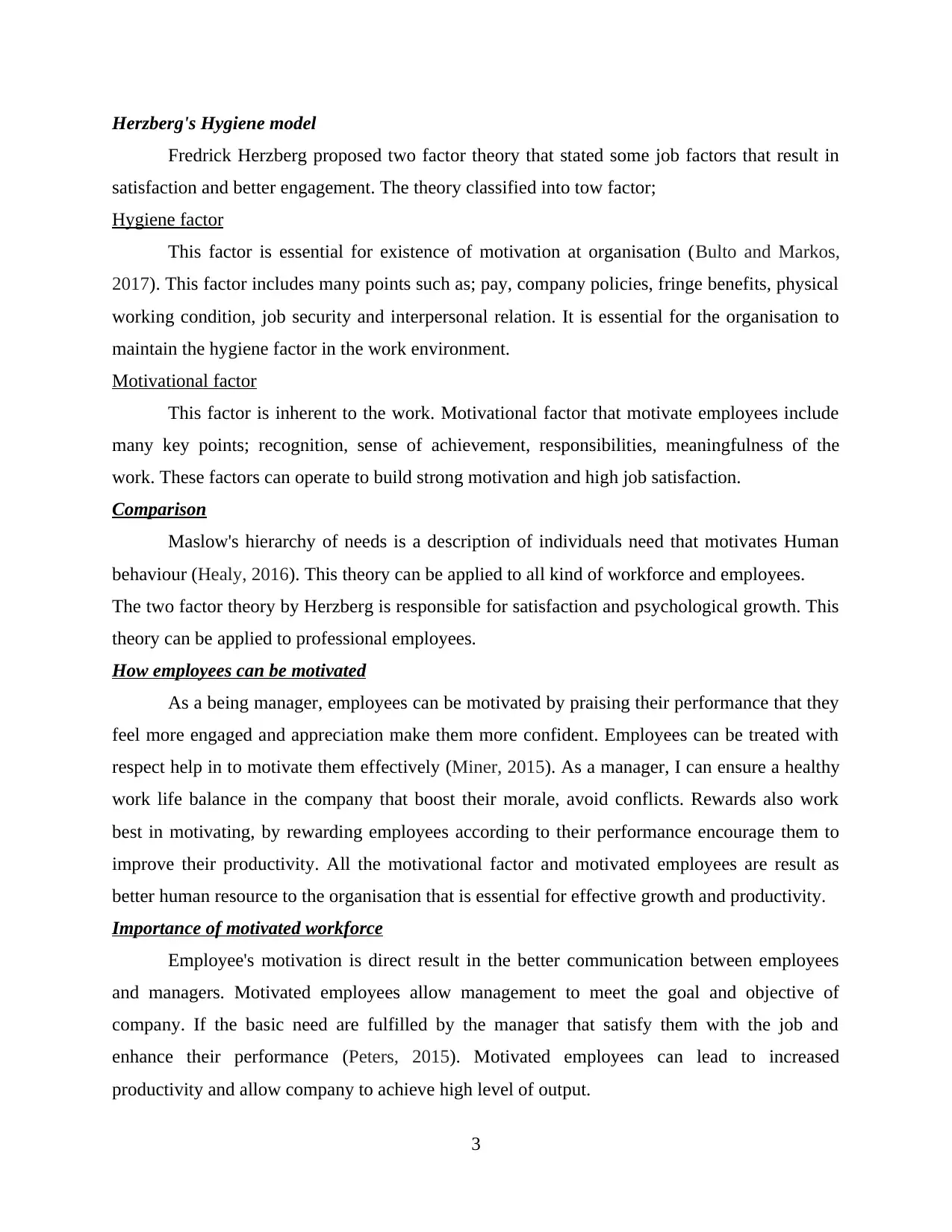
Herzberg's Hygiene model
Fredrick Herzberg proposed two factor theory that stated some job factors that result in
satisfaction and better engagement. The theory classified into tow factor;
Hygiene factor
This factor is essential for existence of motivation at organisation (Bulto and Markos,
2017). This factor includes many points such as; pay, company policies, fringe benefits, physical
working condition, job security and interpersonal relation. It is essential for the organisation to
maintain the hygiene factor in the work environment.
Motivational factor
This factor is inherent to the work. Motivational factor that motivate employees include
many key points; recognition, sense of achievement, responsibilities, meaningfulness of the
work. These factors can operate to build strong motivation and high job satisfaction.
Comparison
Maslow's hierarchy of needs is a description of individuals need that motivates Human
behaviour (Healy, 2016). This theory can be applied to all kind of workforce and employees.
The two factor theory by Herzberg is responsible for satisfaction and psychological growth. This
theory can be applied to professional employees.
How employees can be motivated
As a being manager, employees can be motivated by praising their performance that they
feel more engaged and appreciation make them more confident. Employees can be treated with
respect help in to motivate them effectively (Miner, 2015). As a manager, I can ensure a healthy
work life balance in the company that boost their morale, avoid conflicts. Rewards also work
best in motivating, by rewarding employees according to their performance encourage them to
improve their productivity. All the motivational factor and motivated employees are result as
better human resource to the organisation that is essential for effective growth and productivity.
Importance of motivated workforce
Employee's motivation is direct result in the better communication between employees
and managers. Motivated employees allow management to meet the goal and objective of
company. If the basic need are fulfilled by the manager that satisfy them with the job and
enhance their performance (Peters, 2015). Motivated employees can lead to increased
productivity and allow company to achieve high level of output.
3
Fredrick Herzberg proposed two factor theory that stated some job factors that result in
satisfaction and better engagement. The theory classified into tow factor;
Hygiene factor
This factor is essential for existence of motivation at organisation (Bulto and Markos,
2017). This factor includes many points such as; pay, company policies, fringe benefits, physical
working condition, job security and interpersonal relation. It is essential for the organisation to
maintain the hygiene factor in the work environment.
Motivational factor
This factor is inherent to the work. Motivational factor that motivate employees include
many key points; recognition, sense of achievement, responsibilities, meaningfulness of the
work. These factors can operate to build strong motivation and high job satisfaction.
Comparison
Maslow's hierarchy of needs is a description of individuals need that motivates Human
behaviour (Healy, 2016). This theory can be applied to all kind of workforce and employees.
The two factor theory by Herzberg is responsible for satisfaction and psychological growth. This
theory can be applied to professional employees.
How employees can be motivated
As a being manager, employees can be motivated by praising their performance that they
feel more engaged and appreciation make them more confident. Employees can be treated with
respect help in to motivate them effectively (Miner, 2015). As a manager, I can ensure a healthy
work life balance in the company that boost their morale, avoid conflicts. Rewards also work
best in motivating, by rewarding employees according to their performance encourage them to
improve their productivity. All the motivational factor and motivated employees are result as
better human resource to the organisation that is essential for effective growth and productivity.
Importance of motivated workforce
Employee's motivation is direct result in the better communication between employees
and managers. Motivated employees allow management to meet the goal and objective of
company. If the basic need are fulfilled by the manager that satisfy them with the job and
enhance their performance (Peters, 2015). Motivated employees can lead to increased
productivity and allow company to achieve high level of output.
3
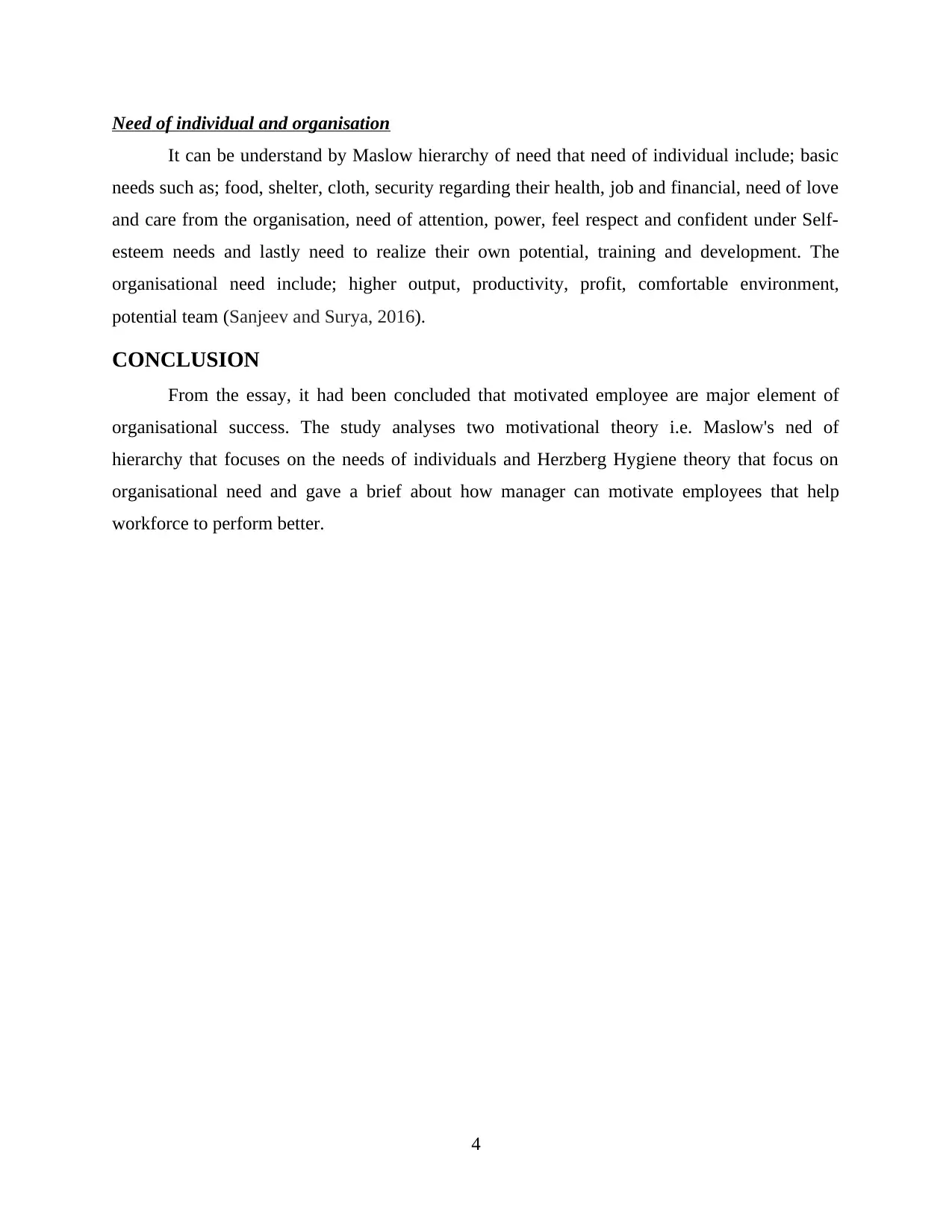
Need of individual and organisation
It can be understand by Maslow hierarchy of need that need of individual include; basic
needs such as; food, shelter, cloth, security regarding their health, job and financial, need of love
and care from the organisation, need of attention, power, feel respect and confident under Self-
esteem needs and lastly need to realize their own potential, training and development. The
organisational need include; higher output, productivity, profit, comfortable environment,
potential team (Sanjeev and Surya, 2016).
CONCLUSION
From the essay, it had been concluded that motivated employee are major element of
organisational success. The study analyses two motivational theory i.e. Maslow's ned of
hierarchy that focuses on the needs of individuals and Herzberg Hygiene theory that focus on
organisational need and gave a brief about how manager can motivate employees that help
workforce to perform better.
4
It can be understand by Maslow hierarchy of need that need of individual include; basic
needs such as; food, shelter, cloth, security regarding their health, job and financial, need of love
and care from the organisation, need of attention, power, feel respect and confident under Self-
esteem needs and lastly need to realize their own potential, training and development. The
organisational need include; higher output, productivity, profit, comfortable environment,
potential team (Sanjeev and Surya, 2016).
CONCLUSION
From the essay, it had been concluded that motivated employee are major element of
organisational success. The study analyses two motivational theory i.e. Maslow's ned of
hierarchy that focuses on the needs of individuals and Herzberg Hygiene theory that focus on
organisational need and gave a brief about how manager can motivate employees that help
workforce to perform better.
4
⊘ This is a preview!⊘
Do you want full access?
Subscribe today to unlock all pages.

Trusted by 1+ million students worldwide
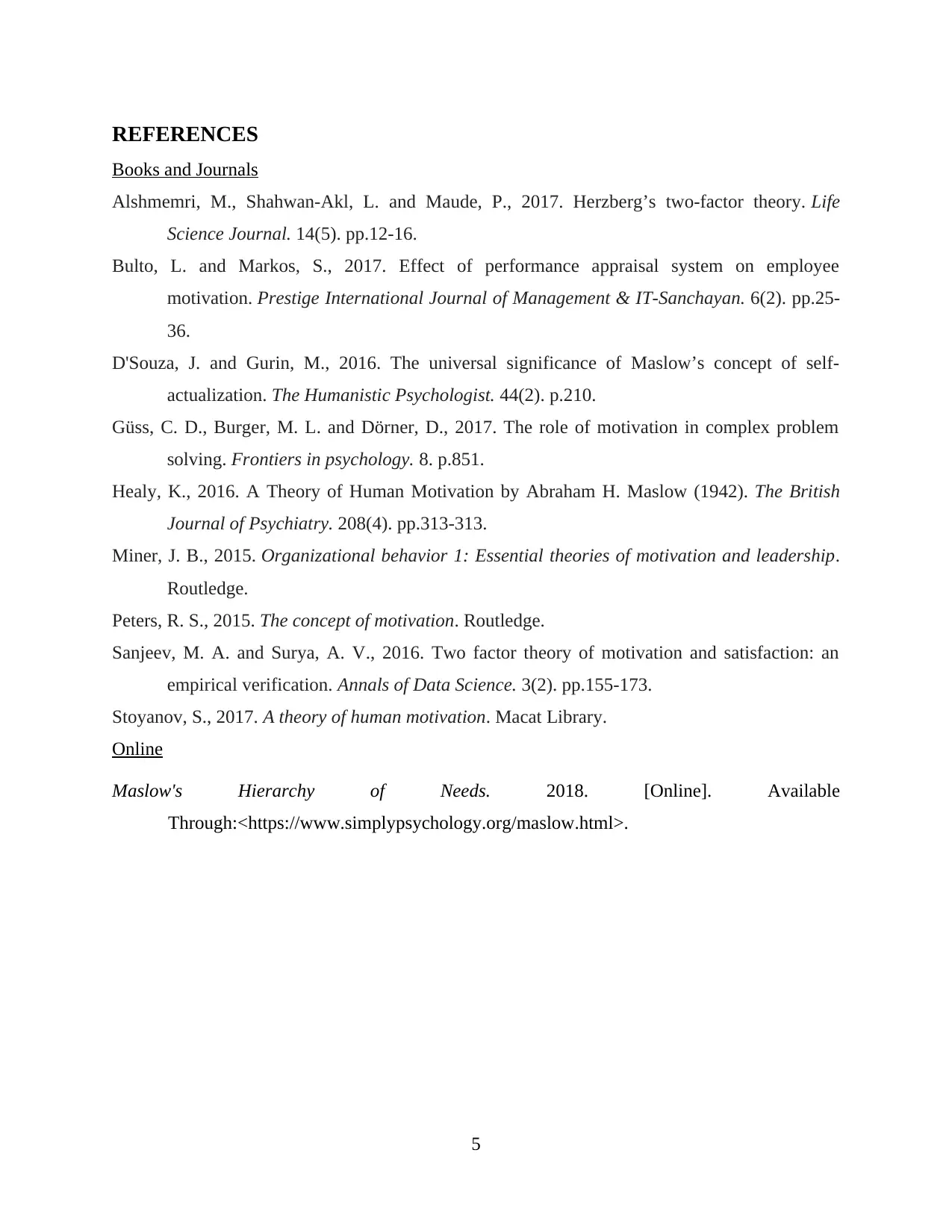
REFERENCES
Books and Journals
Alshmemri, M., Shahwan-Akl, L. and Maude, P., 2017. Herzberg’s two-factor theory. Life
Science Journal. 14(5). pp.12-16.
Bulto, L. and Markos, S., 2017. Effect of performance appraisal system on employee
motivation. Prestige International Journal of Management & IT-Sanchayan. 6(2). pp.25-
36.
D'Souza, J. and Gurin, M., 2016. The universal significance of Maslow’s concept of self-
actualization. The Humanistic Psychologist. 44(2). p.210.
Güss, C. D., Burger, M. L. and Dörner, D., 2017. The role of motivation in complex problem
solving. Frontiers in psychology. 8. p.851.
Healy, K., 2016. A Theory of Human Motivation by Abraham H. Maslow (1942). The British
Journal of Psychiatry. 208(4). pp.313-313.
Miner, J. B., 2015. Organizational behavior 1: Essential theories of motivation and leadership.
Routledge.
Peters, R. S., 2015. The concept of motivation. Routledge.
Sanjeev, M. A. and Surya, A. V., 2016. Two factor theory of motivation and satisfaction: an
empirical verification. Annals of Data Science. 3(2). pp.155-173.
Stoyanov, S., 2017. A theory of human motivation. Macat Library.
Online
Maslow's Hierarchy of Needs. 2018. [Online]. Available
Through:<https://www.simplypsychology.org/maslow.html>.
5
Books and Journals
Alshmemri, M., Shahwan-Akl, L. and Maude, P., 2017. Herzberg’s two-factor theory. Life
Science Journal. 14(5). pp.12-16.
Bulto, L. and Markos, S., 2017. Effect of performance appraisal system on employee
motivation. Prestige International Journal of Management & IT-Sanchayan. 6(2). pp.25-
36.
D'Souza, J. and Gurin, M., 2016. The universal significance of Maslow’s concept of self-
actualization. The Humanistic Psychologist. 44(2). p.210.
Güss, C. D., Burger, M. L. and Dörner, D., 2017. The role of motivation in complex problem
solving. Frontiers in psychology. 8. p.851.
Healy, K., 2016. A Theory of Human Motivation by Abraham H. Maslow (1942). The British
Journal of Psychiatry. 208(4). pp.313-313.
Miner, J. B., 2015. Organizational behavior 1: Essential theories of motivation and leadership.
Routledge.
Peters, R. S., 2015. The concept of motivation. Routledge.
Sanjeev, M. A. and Surya, A. V., 2016. Two factor theory of motivation and satisfaction: an
empirical verification. Annals of Data Science. 3(2). pp.155-173.
Stoyanov, S., 2017. A theory of human motivation. Macat Library.
Online
Maslow's Hierarchy of Needs. 2018. [Online]. Available
Through:<https://www.simplypsychology.org/maslow.html>.
5
1 out of 7
Related Documents
Your All-in-One AI-Powered Toolkit for Academic Success.
+13062052269
info@desklib.com
Available 24*7 on WhatsApp / Email
![[object Object]](/_next/static/media/star-bottom.7253800d.svg)
Unlock your academic potential
Copyright © 2020–2025 A2Z Services. All Rights Reserved. Developed and managed by ZUCOL.





